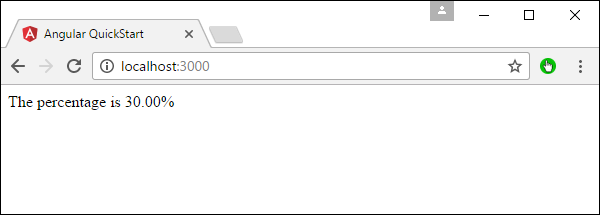- Angular 2-元数据
- Angular 2-元数据(1)
- C++中的数据转换
- C ++中的数据转换(1)
- C++中的数据转换(1)
- C++中的数据转换(1)
- C ++中的数据转换
- C++中的数据转换
- Angular 2-数据显示(1)
- Angular 2-数据显示
- Angular 7库(1)
- Angular 7库
- 在java中转换数据(1)
- 将字符串转换为数据 (1)
- Angular 4-示例
- Angular 4-示例(1)
- Angular 6-数据绑定
- Angular 4-数据绑定
- Angular 4-数据绑定(1)
- Angular 7数据绑定(1)
- Angular 6-数据绑定(1)
- Angular 7数据绑定
- Angular 4 和 Angular 5 的区别(1)
- Angular 4 和 Angular 5 的区别
- 将大列表转换为 R 中的数据框(1)
- 将列表转换为数据框 r (1)
- 将大列表转换为 R 中的数据框
- 在java代码示例中转换数据
- 将数组转换为数据框 python (1)
📅 最后修改于: 2020-10-28 05:11:22 🧑 作者: Mango
Angular 2具有许多可用于转换数据的过滤器和管道。
小写
这用于将输入转换为所有小写字母。
句法
Propertyvalue | lowercase
参量
没有
结果
该属性值将转换为小写。
例
首先,确保以下代码出现在app.component.ts文件中。
import {
Component
} from '@angular/core';
@Component ({
selector: 'my-app',
templateUrl: 'app/app.component.html'
})
export class AppComponent {
TutorialName: string = 'Angular JS2';
appList: string[] = ["Binding", "Display", "Services"];
}
接下来,确保在app / app.component.html文件中存在以下代码。
The name of this Tutorial is {{TutorialName}}
The first Topic is {{appList[0] | lowercase}}
The second Topic is {{appList[1] | lowercase}}
The third Topic is {{appList[2]| lowercase}}
输出
保存所有代码更改并刷新浏览器后,您将获得以下输出。
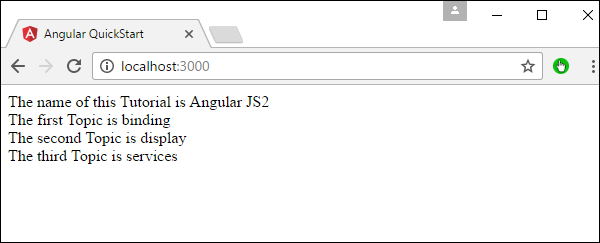
大写
这用于将输入转换为全部大写。
句法
Propertyvalue | uppercase
参量
没有。
结果
该属性值将转换为大写。
例
首先,确保以下代码存在于app.component.ts文件中。
import {
Component
} from '@angular/core';
@Component ({
selector: 'my-app',
templateUrl: 'app/app.component.html'
})
export class AppComponent {
TutorialName: string = 'Angular JS2';
appList: string[] = ["Binding", "Display", "Services"];
}
接下来,确保在app / app.component.html文件中存在以下代码。
The name of this Tutorial is {{TutorialName}}
The first Topic is {{appList[0] | uppercase }}
The second Topic is {{appList[1] | uppercase }}
The third Topic is {{appList[2]| uppercase }}
输出
保存所有代码更改并刷新浏览器后,您将获得以下输出。
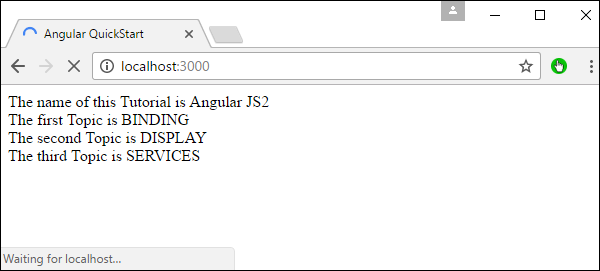
片
这用于从输入字符串切出一段数据。
句法
Propertyvalue | slice:start:end
参量
-
start-这是切片应从其开始的起始位置。
-
end-这是切片应从其开始的起始位置。
结果
将根据起点和终点位置对属性值进行切片。
例
首先确保在app.component.ts文件中存在以下代码
import {
Component
} from '@angular/core';
@Component ({
selector: 'my-app',
templateUrl: 'app/app.component.html'
})
export class AppComponent {
TutorialName: string = 'Angular JS2';
appList: string[] = ["Binding", "Display", "Services"];
}
接下来,确保在app / app.component.html文件中存在以下代码。
The name of this Tutorial is {{TutorialName}}
The first Topic is {{appList[0] | slice:1:2}}
The second Topic is {{appList[1] | slice:1:3}}
The third Topic is {{appList[2]| slice:2:3}}
输出
保存所有代码更改并刷新浏览器后,您将获得以下输出。
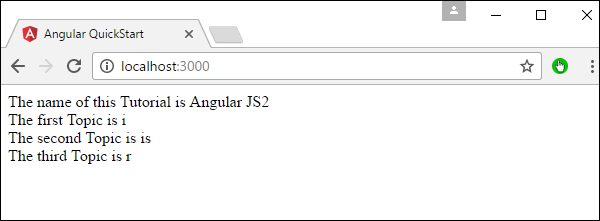
日期
这用于将输入字符串转换为日期格式。
句法
Propertyvalue | date:”dateformat”
参量
dateformat-这是输入字符串应转换为的日期格式。
结果
该属性值将转换为日期格式。
例
首先,确保以下代码出现在app.component.ts文件中。
import {
Component
} from '@angular/core';
@Component ({
selector: 'my-app',
templateUrl: 'app/app.component.html'
})
export class AppComponent {
newdate = new Date(2016, 3, 15);
}
接下来,确保在app / app.component.html文件中存在以下代码。
The date of this Tutorial is {{newdate | date:"MM/dd/yy"}}
输出
保存所有代码更改并刷新浏览器后,您将获得以下输出。
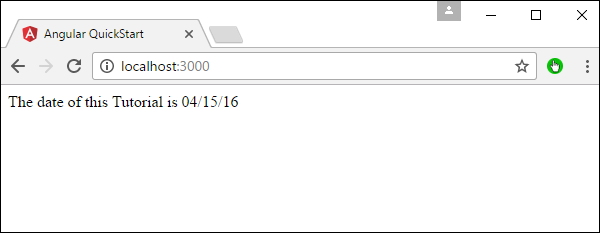
货币
这用于将输入字符串转换为货币格式。
句法
Propertyvalue | currency
参量
没有。
结果
属性值将转换为货币格式。
例
首先,确保以下代码存在于app.component.ts文件中。
import {
Component
} from '@angular/core';
@Component ({
selector: 'my-app',
templateUrl: 'app/app.component.html'
})
export class AppComponent {
newValue: number = 123;
}
接下来,确保在app / app.component.html文件中存在以下代码。
The currency of this Tutorial is {{newValue | currency}}
输出
保存所有代码更改并刷新浏览器后,您将获得以下输出。

百分比
这用于将输入字符串转换为百分比格式。
句法
Propertyvalue | percent
参量
没有
结果
该属性值将转换为百分比格式。
例
首先,确保以下代码存在于app.component.ts文件中。
import {
Component
} from '@angular/core';
@Component ({
selector: 'my-app',
templateUrl: 'app/app.component.html'
})
export class AppComponent {
newValue: number = 30;
}
接下来,确保在app / app.component.html文件中存在以下代码。
The percentage is {{newValue | percent}}
输出
保存所有代码更改并刷新浏览器后,您将获得以下输出。
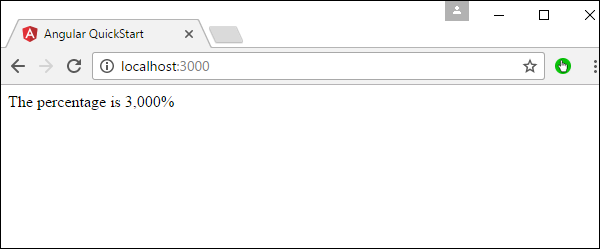
百分比管道还有另一种变化,如下所示。
句法
Propertyvalue | percent: ‘{minIntegerDigits}.{minFractionDigits}{maxFractionDigits}’
参量
-
minIntegerDigits-这是最小整数位数。
-
minFractionDigits-这是分数位数的最小数目。
-
maxFractionDigits-这是小数位数的最大数目。
结果
属性值将转换为百分比格式
例
首先,确保以下代码存在于app.component.ts文件中。
import {
Component
} from '@angular/core';
@Component ({
selector: 'my-app',
templateUrl: 'app/app.component.html'
})
export class AppComponent {
newValue: number = 0.3;
}
接下来,确保在app / app.component.html文件中存在以下代码。
The percentage is {{newValue | percent:'2.2-5'}}
输出
保存所有代码更改并刷新浏览器后,您将获得以下输出。
